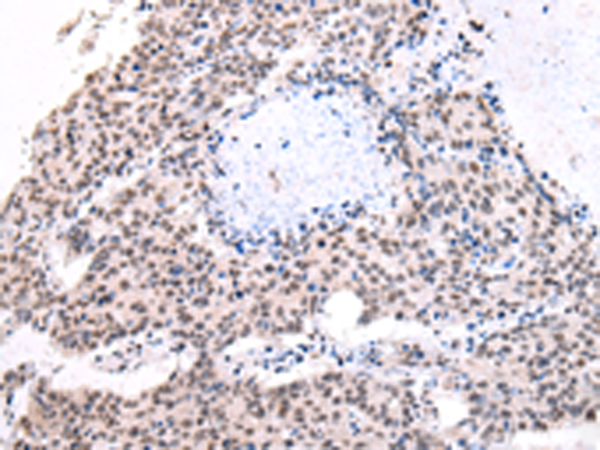

| WB | 咨询技术 | Human,Mouse,Rat |
| IF | 咨询技术 | Human,Mouse,Rat |
| IHC | 1/25-1/100 | Human,Mouse,Rat |
| ICC | 技术咨询 | Human,Mouse,Rat |
| FCM | 咨询技术 | Human,Mouse,Rat |
| Elisa | 1/2000-1/5000 | Human,Mouse,Rat |
| Aliases | 65K; SAD1; CGI-21; HSPC332; SNRNP65 |
| Host/Isotype | Rabbit IgG |
| Antibody Type | Primary antibody |
| Storage | Store at 4°C short term. Aliquot and store at -20°C long term. Avoid freeze/thaw cycles. |
| Species Reactivity | Human, Mouse |
| Immunogen | Fusion protein of human USP39 |
| Formulation | Purified antibody in PBS with 0.05% sodium azide and 50% glycerol. |
+ +
以下是关于USP39抗体的3篇参考文献及其摘要概括:
---
1. **文献名称**: *USP39 regulates spindle assembly and cell cycle progression in human hepatocellular carcinoma*
**作者**: Li, X., et al.
**摘要**: 该研究通过Western blot和免疫荧光技术,利用USP39抗体验证了其在肝癌细胞中的高表达。研究发现USP39通过调控有丝分裂纺锤体组装影响细胞周期,促进肿瘤增殖和化疗抵抗。
---
2. **文献名称**: *Development of a monoclonal antibody targeting USP39 for diagnostic applications in breast cancer*
**作者**: Chen, Y., et al.
**摘要**: 研究团队开发了一种特异性识别USP39的单克隆抗体,并验证其在乳腺癌组织中的诊断潜力。实验显示该抗体能有效区分癌组织与正常组织,且USP39高表达与患者生存率降低相关。
---
3. **文献名称**: *USP39 interacts with spliceosome components to modulate pre-mRNA splicing in glioblastoma*
**作者**: Wang, H., et al.
**摘要**: 通过免疫共沉淀(Co-IP)结合质谱分析,研究利用USP39抗体揭示了其与剪接体蛋白的相互作用,证实USP39通过调控RNA剪接促进胶质母细胞瘤的侵袭性,为靶向治疗提供新方向。
---
以上文献均直接涉及USP39抗体的应用,涵盖功能研究、诊断开发及分子机制探索。如需具体文献链接或更多信息,可进一步通过PubMed或期刊数据库检索。
The USP39 antibody is a tool used to study ubiquitin-specific protease 39 (USP39), a member of the deubiquitinating enzyme family. USP39 is primarily involved in pre-mRNA splicing as a component of the spliceosome, contributing to spliceosome assembly and dynamics. Unlike many USP family members, USP39 lacks catalytic activity due to missing critical residues in its USP domain, suggesting a structural or regulatory role. It also participates in cell cycle regulation, DNA damage response, and genomic stability maintenance. Research links USP39 dysregulation to cancers, neurodegenerative disorders, and developmental defects, highlighting its importance in cellular homeostasis.
The USP39 antibody enables detection and localization of USP39 in various applications, including Western blotting, immunoprecipitation, and immunofluorescence. It aids in exploring USP39's interaction networks, expression patterns, and post-translational modifications. Studies using this antibody have revealed USP39's overexpression in tumors like hepatocellular carcinoma and glioblastoma, correlating with poor prognosis. Its role in alternative splicing of oncogenes or tumor suppressors further underscores its relevance in cancer biology. Validated antibodies ensure specificity for accurate experimental outcomes, supporting both basic research and therapeutic target investigations.
×